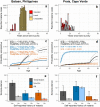Comparison of Commercial ELISA Kits to Confirm the Absence of Transmission in Malaria Elimination Settings
- PMID: 33014975
- PMCID: PMC7509087
- DOI: 10.3389/fpubh.2020.00480
Comparison of Commercial ELISA Kits to Confirm the Absence of Transmission in Malaria Elimination Settings
Abstract
Background: Antimalarial antibody measurements are useful because they reflect historical and recent exposure to malaria. As such, they may provide additional information to assess ongoing transmission in low endemic or pre-elimination settings where cases are rare. In addition, the absence of antibody responses in certain individuals can indicate the cessation of transmission. Commercial malaria enzyme-linked immunosorbent assays (ELISA) detect antimalarial antibodies and are commonly used to screen blood donations for possible malaria infection. However, there is no standardized test to detect antimalarial antibodies for epidemiological use. Here we compared five commercially available ELISA kits (Trinity Biotech, newbio, DiaPro, Cellabs, and NovaTec) in search of a standardized tool for supporting claims of absence of malaria transmission. For comparison, a research-based (RB) ELISA protocol was performed alongside the commercial kits. Results: The commercial kits were first compared using serum samples from known malaria-unexposed individuals (n = 223) and Toxoplasma-infected individuals (n = 191) to assess specificity and cross-reactivity against non-malaria infections. In addition, 134 samples from ≥10-year-olds collected in a hyperendemic region in the Gambia in the early 1990s were used to assess sensitivity. Three out of five kits showed high sensitivity (90-92%), high specificity (98-99%), low cross-reactivity (0-3%) and were considered user-friendly (Trinity Biotech, newbio and NovaTec). Two of these kits (Trinity Biotech and NovaTec) were taken forward for epidemiological evaluation and results were compared to those using the RB-ELISA. Samples from two pre-elimination settings (Praia, Cape Verde; n = 1,396, and Bataan, the Philippines; n = 1,824) were tested. Serological results from both the Trinity Biotech kit and the RB-ELISA concurred with recent passively detected case counts in both settings. Results from the Trinity Biotech kit reflected a significant decrease in the number of reported cases in Bataan in the 1990s better than the RB-ELISA. Results from the NovaTec kit did not reflect transmission patterns in either setting. Conclusion: The Trinity Biotech commercial ELISA kit was considered reliable for epidemiological use and accurately described transmission patterns in two (previously) malaria endemic settings. The use of this simple and standardized serological tool may aid national control and elimination programs by confirming that regions are free from malaria.
Keywords: ELISA; IgG; antibody; commercial ELISA kits; elimination; immunoglobulin; malaria; pre-elimination.
Copyright © 2020 van den Hoogen, Bareng, Alves, Reyes, Macalinao, Rodrigues, Fernandes, Goméz, Hall, Singh, Fornace, Luchavez, Kitchen, Chiodini, Espino, Tetteh, Stresman, Sepúlveda and Drakeley.
Figures



Similar articles
-
Analytical approaches for antimalarial antibody responses to confirm historical and recent malaria transmission: an example from the Philippines.Lancet Reg Health West Pac. 2023 May 20;37:100792. doi: 10.1016/j.lanwpc.2023.100792. eCollection 2023 Aug. Lancet Reg Health West Pac. 2023. PMID: 37693871 Free PMC article.
-
Risk of transfusion-transmitted malaria: evaluation of commercial ELISA kits for the detection of anti-Plasmodium antibodies in candidate blood donors.Malar J. 2019 Jan 22;18(1):17. doi: 10.1186/s12936-019-2650-0. Malar J. 2019. PMID: 30670018 Free PMC article.
-
Assessment of assay sensitivity and precision in a malaria antibody ELISA.J Immunoassay Immunochem. 2003;24(1):89-112. doi: 10.1081/IAS-120018471. J Immunoassay Immunochem. 2003. PMID: 12680609
-
Performance and Application of Commercially Available Loop-Mediated Isothermal Amplification (LAMP) Kits in Malaria Endemic and Non-Endemic Settings.Diagnostics (Basel). 2021 Feb 18;11(2):336. doi: 10.3390/diagnostics11020336. Diagnostics (Basel). 2021. PMID: 33670618 Free PMC article. Review.
-
Chapter 5. Potential contribution of sero-epidemiological analysis for monitoring malaria control and elimination: historical and current perspectives.Adv Parasitol. 2009;69:299-352. doi: 10.1016/S0065-308X(09)69005-9. Adv Parasitol. 2009. PMID: 19622411 Review.
Cited by
-
When the available blood supply mismatches the needs of the patient.Blood Transfus. 2023 Sep;21(5):378-384. doi: 10.2450/2022.0166-22. Epub 2022 Nov 4. Blood Transfus. 2023. PMID: 36346886 Free PMC article.
-
Factors related to human-vector contact that modify the likelihood of malaria transmission during a contained Plasmodium falciparum outbreak in Praia, Cabo Verde.Front Epidemiol. 2022 Nov 25;2:1031230. doi: 10.3389/fepid.2022.1031230. eCollection 2022. Front Epidemiol. 2022. PMID: 38455281 Free PMC article.
-
Analytical approaches for antimalarial antibody responses to confirm historical and recent malaria transmission: an example from the Philippines.Lancet Reg Health West Pac. 2023 May 20;37:100792. doi: 10.1016/j.lanwpc.2023.100792. eCollection 2023 Aug. Lancet Reg Health West Pac. 2023. PMID: 37693871 Free PMC article.
-
Plasmodium knowlesi: the game changer for malaria eradication.Malar J. 2022 May 3;21(1):140. doi: 10.1186/s12936-022-04131-8. Malar J. 2022. PMID: 35505339 Free PMC article. Review.
-
Diagnostic Methods for Non-Falciparum Malaria.Front Cell Infect Microbiol. 2021 Jun 17;11:681063. doi: 10.3389/fcimb.2021.681063. eCollection 2021. Front Cell Infect Microbiol. 2021. PMID: 34222049 Free PMC article. Review.
References
-
- Bruce-Chwatt LJ, Draper CC, Avramidis D, Kazandzoglou O. Sero-epidemiological surveillance of disappearing malaria in Greece. J Trop Med Hyg. (1975) 78:194–200. - PubMed
Publication types
MeSH terms
LinkOut - more resources
Full Text Sources
Medical
Research Materials

